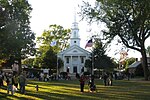Robinson State Park
1934 establishments in MassachusettsAgawam, MassachusettsParks in Hampden County, MassachusettsProtected areas established in 1934Springfield metropolitan area, Massachusetts ... and 3 more
State parks of MassachusettsUse mdy dates from August 2023Westfield, Massachusetts

Robinson State Park is a state-owned, public recreation area located mostly in the town of Agawam with a small section in Westfield, Massachusetts. The narrow, 1,025-acre (415 ha) state park follows the course of the meandering Westfield River which forms the park's northern border. The park is managed by the Massachusetts Department of Conservation and Recreation.
Excerpt from the Wikipedia article Robinson State Park (License: CC BY-SA 3.0, Authors, Images).Robinson State Park
Westfield River Trail,
Geographical coordinates (GPS) Address Nearby Places Show on map
Geographical coordinates (GPS)
| Latitude | Longitude |
|---|---|
| N 42.090555555556 ° | E -72.664722222222 ° |
Address
Westfield River Trail
Westfield River Trail
01030
Massachusetts, United States
Open on Google Maps








